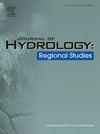Multiobjective risk-based optimization for real-time interbasin water diversion under decomposed chance-constrained total water use
IF 4.7
2区 地球科学
Q1 WATER RESOURCES
引用次数: 0
Abstract
Study Region
The eastern route of the South-to-North Water Diversion Project in Jiangsu Province, China, a critical national interbasin water diversion system for alleviating water shortages.
Study Focus
This study proposed a risk-based multiobjective optimization model for interbasin water diversion, with chance constraint on total water use. Probabilistic forecasting of local streamflow and water demand was adopted to identify operation risks. Multiobjective stochastic optimization was then introduced to minimize the risks of water shortages and spillages. Furthermore, a decomposition method was proposed to investigate the regime of water use under different hydrological conditions, and the decomposed chance constraint was incorporated into the optimization model. Finally, two indices were designed to assess the value of forecasts and water utilization efficiency.
New Hydrological Insights for the Region
Developing a robust and efficient water diversion strategy based on forecast information is crucial. The proposed method with case study provides the following new hydrological insights: (1) conflict occurs between water diversion, spillage, and shortage, with water shortage and diversion representing major contradictions. (2) high-skilled forecasting helps reduce water diversion (22.3 %), spillage (over 60 %), and shortage (approximately 10 %), indicating considerable value for promoting the benefits of water diversion operations. (3) water use constraint focuses restricting excessive water diversion (30.8 %), exploiting the potential of local water supply, increasing in local water utilization efficiency from 92.8 % to 93.4 %.
求助全文
约1分钟内获得全文
求助全文
来源期刊

Journal of Hydrology-Regional Studies
Earth and Planetary Sciences-Earth and Planetary Sciences (miscellaneous)
CiteScore
6.70
自引率
8.50%
发文量
284
审稿时长
60 days
期刊介绍:
Journal of Hydrology: Regional Studies publishes original research papers enhancing the science of hydrology and aiming at region-specific problems, past and future conditions, analysis, review and solutions. The journal particularly welcomes research papers that deliver new insights into region-specific hydrological processes and responses to changing conditions, as well as contributions that incorporate interdisciplinarity and translational science.
 求助内容:
求助内容: 应助结果提醒方式:
应助结果提醒方式:


